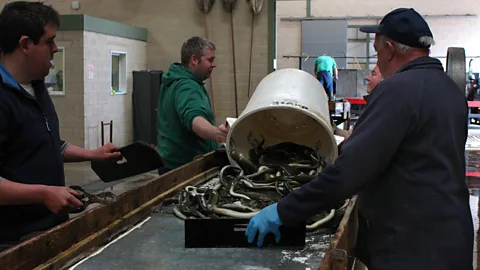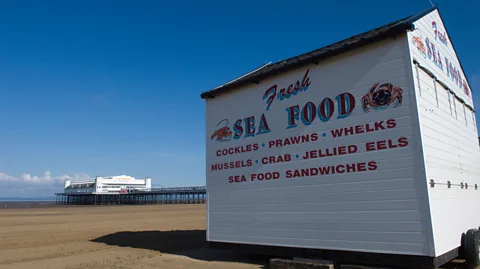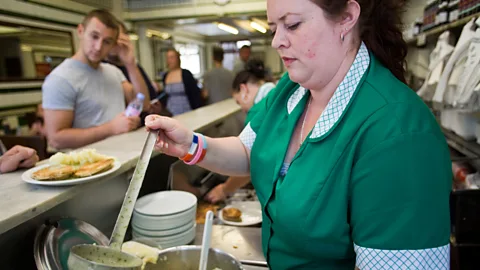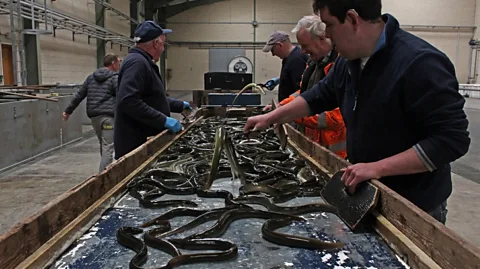The UK’s most slippery export
 Chris Baraniuk
Chris BaraniukTen men are waiting in a cavernous warehouse on the northwestern tip of Lough Neagh, Northern Ireland. A small truck carrying several tanks pulls up. As the first tank is spilled out, water and a mass of wriggling eels flood down a chute and the workers quickly begin sorting them.
The men’s job is to spot any eels that are too small: less than 40cm in length. These weedy specimens are quickly flicked off the chute and allowed to writhe through a grate on the floor below. From there they may swim back out into the lough, free to live another day.
The eels are black, shiny, and full of vigour. The Irish poet Seamus Heaney described them as “phosphorescent, sinewed slime” in a tribute to the fishermen of Lough Neagh, who have been working the lough (Irish for lake) for centuries.
“The very look of an eel actually turns some people off,” says Pat Close, chairman of the Lough Neagh fishermen’s co-operative. “They squirm at the idea of it – handling or eating it.”
Even so, these eels are among Northern Ireland’s greatest agricultural prizes. The lake has Europe’s largest wild caught eel fishery. And not only are the eels delicious when smoked, but thanks to the special quality of the fish in this region, the European Union awarded them Protected Geographic Indicator (PGI) status in 2011. The accolade is shared by Champagne grapes and Parma ham.
And like those foodstuffs, eels aren’t cheap. Packs of smoked eels are being sold for £9 – much more than a packet of the more common delicacy smoked salmon, which might set you back a fiver at most. More reasonable prices might be available in restaurants which buy in bulk.
 Chris Baraniuk
Chris BaraniukLough Neagh eels, too, have a historic pedigree. “I can look at lists of boat owners today and see the same family names that were in records 60 or 70 years ago,” says Close, who has worked at the eel fishery for more than 28 years. In fact, archaeological evidence suggests that people were fishing for and eating eels in what is now Northern Ireland as much as 6,000 years ago.
Yet other than the families who live on the shores of the lough, and in areas like the East End of London where jellied eel and eel pies were once popular, British people have never been very enthusiastic about eels. Of the 400 tonnes of fish produced annually at Lough Neagh, most is exported to Germany and the Netherlands; in total, 80% of the fishery’s eels end up on the European continent.
While there is demand for eels, especially from mainland Europe, it has been gradually falling. Worse, stocks of European eel – the species fished here – still haven’t recovered from a population crash that happened in the 1980s.
 Alamy
AlamyThe European eel spawns in the North Atlantic, migrating as a juvenile to inland freshwater systems like Lough Neagh. That migration into the freshwater system is known as “recruitment”. A decrease in recruitment numbers, of course, means fewer eels at Lough Neagh – and that’s exactly what happened in 1982.
“In 1982, we recruited 11 million which was bang on target,” says Close. “The following year it dropped to three quarters of a million. Obviously the hope at that time was it was some sort of temporary blip. But sadly, history now shows that it was anything but.”
The crash was witnessed at fisheries across Europe. The last time population numbers dipped on the same scale was in the early 1900s; no one knows what caused either of these events. Some researchers have queried the role of pollutants, over-fishing in some areas and the effect of hydroelectric dams – the dams can kill huge numbers of eels.
There is also a climate-based theory. In a cyclical weather system called the North Atlantic Oscillation (NAO), storms and depressions can change direction – either from north to south, or vice versa – as they cross the North Atlantic towards Europe. Eels are highly sensitive to pressure changes like these, and the timing fits: there is some evidence that the NAO follows a 60- to 80-year cycle – much like the El Niño oscillation in the Pacific may observe an interval of seven or eight years. What effect this has on eels, though, and whether it accounts for the population crashes of the early 1900s and 1980s, is difficult to say.
 Alamy
AlamyIn an effort to safeguard the Lough Neagh population, the fishery has – since 1984 – been manually recruiting young eels, known as elvers, from other ecosystems.
It has also been working to establish conservation techniques with the help of Derek Evans of Belfast’s Agri-Food and Biosciences Institute (AFBI).
Evans and some PhD students recently developed a method of surgically attaching electronic, acoustic tags to the eels to track how many progress out of the system in later life to breed. In one experiment they tagged 60 individuals – at a cost of $46,000. As a result, they were able to listen out for radio “pings”, designed to be unique to each eel, at a series of listening stations around the lough. Some of the fish were even picked up later during their migration at a listening station for tagged salmon near Donegal.
The fishery also now has strict quotas on when and how fishing can take place. None is allowed on the weekend, for example, and fishermen aren’t allowed to bring up lines or nets that were set the previous day before 4:30am. The co-operative also sets a daily weight limit on the amount of fish that may be landed. The ultimate goal is to have at least 40% “escapement” – the number of mature, silver eels which migrate back out of the system to the Atlantic. In recent years, the fishery has been able to meet this target.
 Chris Baraniuk
Chris BaraniukThe European eel is actually listed as critically endangered by the International Union of Conservation for Nature (IUCN). But Close argues that if it weren’t for farming with fisheries championing responsible fishery plans, including re-stocking in key areas and constant monitoring of the eels’ health, the animals might be even worse off.
There is also the threat of a suspected black market trade to countries like China. Under current EU rules, the export of European eels to Asia is banned. But given the sheer size of the market there for the fish, this may ironically be encouraging black market activity – and hampering the efforts of trustworthy fisheries, Close says. “If we were able to get a better return for our fish, we could afford to invest more money in restocking,” he explains.
For now, the co-operative is hoping that recognition of its conservation efforts and perhaps some long-overdue affection for a local product can help raise the eels’ profile.
 Chris Baraniuk
Chris BaraniukIn the last two months, the fishery has been marketing a high-end smoked eel product to sell within the UK. Developed in conjunction with a small business smoker at the southern end of the lough in Craigavon, the process requires that the eels are smoked for six hours at a time at a low temperature – which allows them to retain their oil and develop a buttery flavour.
The O’Chatten Smokery has so far produced nearly 1,000 packets of smoked eel which sell for around $13 each. Owner Andrew Chatten has experimented with a variety of different woods, including oak and maple, to get the right flavour. But it was at the Balmoral Show, an annual agricultural exhibition in Northern Ireland, that he got his first sense that there was an untapped market on his doorstep.
“Young trendy guys were coming up and tasting it,” Chatten recalls. “The other big shock to me was young kids, young kids were blown away.”
A handful of packets even made their way to London’s luxury grocers Fortnum & Mason as part of a promotion celebrating Northern Irish food and drink.
In Belfast, restaurants are most likely to buy the product: the city’s Michelin-starred OX, for example, featured them on the menu recently.
Still, most people in the UK have yet to sample it – or to hear of the plight of the European eel. That might change. In the meantime, the fishermen of Lough Neagh work on – toiling through the small hours, dragging their nets late into the morning.
This story is a part of BBC Britain: a series focused on exploring this extraordinary island, one story at a time. Readers outside of the UK can see every BBC Britain story by heading to the Britain homepage; you also can see our latest stories by following us on Facebook and Twitter.
To comment on this story or anything else you have seen on BBC Capital, please head over to our Facebook page or message us on Twitter.
If you liked this story, sign up for the weekly bbc.com features newsletter, called “If You Only Read 6 Things This Week”. A handpicked selection of stories from BBC Future, Earth, Culture, Capital, Travel and Autos, delivered to your inbox every Friday.
